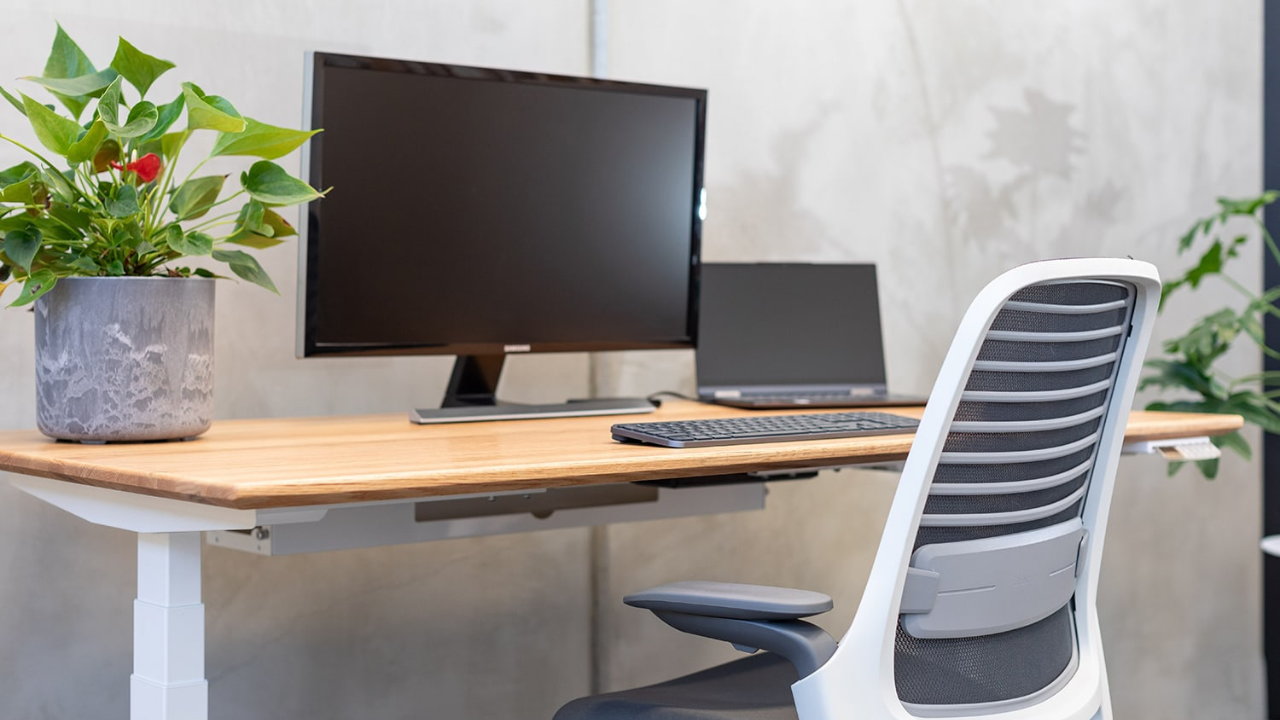A good ergonomic office chair is an investment. You use it daily for prolonged hours, significantly impacting your health and productivity. Therefore, choosing an office chair is an essential decision.
However, with so many options on the market, it can be hard to know where to start when choosing an office chair. What features are essential? And which are ideal for your particular use case? We consider all this in the 10 factors below to help you find the perfect chair.
1. Chair height
When choosing an office chair, consider its height to ensure comfort. Some chairs are height-adjustable, while others aren't. For flexibility, always choose the latter. Height-adjustable office chairs feature a pneumatic adjustment lever that allows you to raise or lower the seat.
For optimal comfort, the height of your office chair should be adjustable to your height. You should be able to sit with your thighs parallel to the floor, your feet flat on the ground, and your knees at a 90-degree angle for maximum comfort. Use our desk height calculator to find the ideal range for a specific height.
2. Chair seating
Your office chair's seat should be adjustable and wide enough to support your thighs without putting pressure on your hips. It should be deep enough that you can sit back in the chair with some space between your back and the back of the chair.
Additionally, the material should be breathable so you do not overheat while sitting in it. Softer seats are not preferable. Soft seat cushions can cause back pain and make sitting for long periods uncomfortable. On the other hand, if it is extremely firm, you are prone to soreness in your backside.
We recommend a balance between the two. Mesh chairs, for example, have taught seats, whereas fabric chairs feel increasingly firmer. For seat adjustability, choose ergonomic chairs with adjustable seat height and depth to find a comfortable position for yourself.
3. Lumbar support
Lumbar support is crucial to your sitting posture. Office chairs with lumbar support protect your lower back and support your spinal cord. Some ergonomic chairs also include lumbar support that is adjustable to your preference.
It's best to try out this feature to get support for your lower back when needed. If you're shopping online, choose office chairs with adjustable lumbar supports. Well-fitted lumbar supports minimise strain or compression on your spine's lumbar discs.

4. Adjustable backrests
If the backrest is attached to the seat, you should be able to adjust it forward and backwards. It is preferable to have a locking mechanism that keeps it in place so that the back does not suddenly tilt backwards. A backrest that is distinct from the seat should be height and angle-adjustable.
Office chairs with adjustable backrests can be beneficial. They improve comfort, relieve back and shoulder pain, and promote good sitting posture. Additionally, they allow you to adjust the chair to suit various use cases.
5. Chair armrests
The armrests should be adjustable to position your arms while typing or using a mouse comfortably.
Like the office chair seat, armrests can be adjusted in many ways. Higher-end office chairs have armrests that are 4D adjustable: height, width, depth, and pivot. If the chair you choose has fixed armrests, try it before purchasing it.
The armrests of your office chair should also be soft so that they don’t put pressure on your wrists or elbows. This is especially important if you intend to use your office chair for prolonged periods.
Finding a height and width adjustable office chair is a smart compromise; they are the most critical. The goal is to have enough adjustment to keep your shoulders and neck relaxed and to prevent slouching.
6. Chair headrest
The headrest of an ideal office chair should be adjustable so that you can find a comfortable position for your head and neck. Most headrests are height-adjustable. The headrest should also be soft so as not to put pressure on your head or neck.
Headrests are most valuable when seated in a relaxed or reclined position. Depending on your application, you may not need one. For example, if you use your office chair in a home library, you are more likely to rely on the headrest than in a traditional office.
7. Aesthetics
While the features of the ergonomic office chair you select are crucial, so are the looks. Choose office chairs that complement your home office setup and assist you in setting a tone in the area, influencing your emotions. Does your perfect office chair contribute to or detract from the office aesthetic you seek?
Choosing aesthetically beautiful office chairs can also boost your expenditure, especially if functionality is considered. You may find office chairs that complement your home office but lack key ergonomic qualities. Avoid them at all costs. Spending a lot of money on an office chair may seem excessive until you realise how it improves and transforms the look and feel of your entire home office.
8. Other ergonomic features
Ergonomic chairs are preferable to traditional chairs. The former includes numerous adjustable features that allow you to customise the chair to your ideal comfort level.
Depending on the price point, some chairs include more ergonomic features than others. These added features aren't necessarily essential, but they can help you stay comfortable for extended periods. They include but are not limited to:
- A tilt lock function that allows you to rock back and forth in your office chair and be able to have the chair hold that position.
- A Forward tilt function that allows the chair to prop forward. Thus, improving your comfort during work hours.
- Casters that allow you to move freely in your chair and are suitable for the type of flooring in your office.
- A swivel feature that makes it easier for you to reach different points of your workstation without straining excessively.

9. Warranty and return policy
The chair's warranty may cover any flaws in materials or craftsmanship, allowing you to receive a replacement if something goes wrong. Most office chairs have one to ten years of warranties, but some have lifetime warranties. The office chair warranty may also cover only certain parts; be sure to read the warranty carefully before purchasing.
You may also find vendors and manufacturers who will let you return the office chair for a period if it does not meet your expectations. This is especially important when shopping online. Return policies often range from one to three weeks from the date of purchase.
10. Price
When spending on any product, the rule of thumb is never to choose money over value; the same applies here. The price of the chair should be within your budget so that you don’t overspend, but it shouldn't be restrictive to prevent you from finding your ideal ergonomic chair.
Types of Office Chairs
Many types of office chairs exist for various use cases. The Australian market offers four basic types: ergonomic saddle chairs, ergonomic ball chairs, traditional office chairs, gaming chairs, and stools.
1. Saddle chairs
Saddle chairs are named after their resemblance to equestrian saddles. They position your body as if you were riding a horse, with your legs apart, knees lowered, and pelvis tilted forwards.
Saddle seats provide distinct advantages and are commonly seen in dental clinics and beauty salons. They allow the spine to rest in its natural S curve, activate the core, and relieve lower back discomfort. Saddle seats also enable daily movement and prevent sedentary behaviour.
2. Ball chairs
A ball chair adds exercise to your workplace. While it cannot replace traditional ergonomic chairs, it provides stages for an hour or two daily since it provides a workout in short spurts.
Furthermore, because they encourage frequent shifts, they enhance energy use, help burn more calories, and prevent sitting in one position too long. The disadvantage? They do not provide proper seating positions and or lumbar and back support.
3. Gaming chairs
Unlike office chairs, gaming chairs are frequently brightly coloured and branded with custom logos, movies, and gaming characters to make them stand out. They are made to provide an immersive gaming experience. And they are more expensive.
Gaming desks are more flexible than ergonomic chair options. They have superb reclining angles and great ergonomic and customisable features, allowing you to settle in comfortably.

4. Stools
Stools are the shortest type of office chair and don't usually have wheels or a backrest. They're perfect for short tasks or when you frequently need to move around your workspace. Stools are also ideal for use with standing desks; they keep you in a position where you're neither sitting nor standing, which can be good for your health.
Why You Need an Office Chair?
Anyone who spends much time at a desk should invest in an office chair. It is more comfortable than sitting on a hard surface, but it can also help improve posture and lower the chance of experiencing back or neck pain, thus improving health in the long run.
An office chair can also help you stay productive during long work days by supporting your back and keeping you from exhaustion. And, if you work from home, an office chair can help you focus by creating a separate workstation.

Budgeting for an Office Chair
The cost of an office chair depends on several factors, including the type of chair, the material it is made from, the features it offers, and the brand.
The most basic office chairs can be found for as little as $100, but these are often flimsy and uncomfortable. You can expect to pay around $300 to $500 for a good-quality, budget-option, comfortable chair. The range of chairs between $500 and $1000 are ideal for work-from-home setups. Anything above this, you're paying for luxury and extended functionalities.
When deciding your budget, you must consider what chair you need. If you spend most of your day sitting at a desk, a high-quality ergonomic office chair, like the ErgoTune Supreme, is a wise investment. These chairs reduce strain on the back and neck and can be adjusted to fit your body type.
The build material of an office chair greatly influences its cost. Leather chairs are more expensive than fabric chairs, but they offer a luxurious feel and look great in any office setting. Mesh chairs, on the other hand, are ideal for warmer climates and offer a balance between the two.

Should You Buy an Office Chair?
Investing in an office chair is prudent for comfort, ergonomic support, and enhanced productivity in a workspace. Yet, it can be challenging to find the perfect office chair among the numerous available options. With the above considerations in mind, you should be able to find a chair that will give you the necessary support and comfort throughout the day.
A quality office chair promotes better posture and contributes to overall well-being, making it a worthwhile investment for those spending extended hours at a desk. Remember to watch your budget; many fantastic chairs are available that won't cost a fortune.








